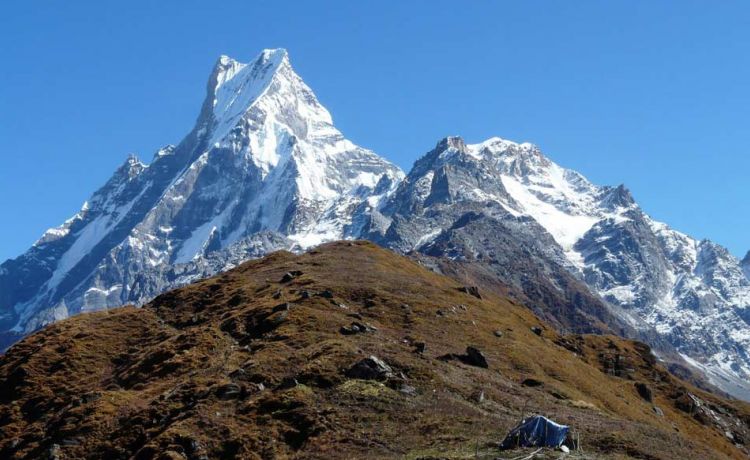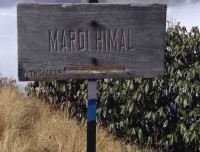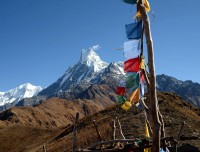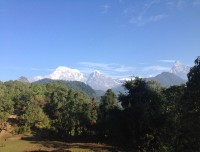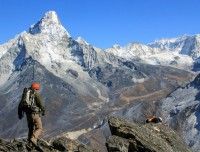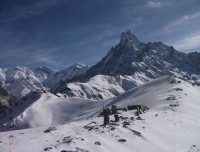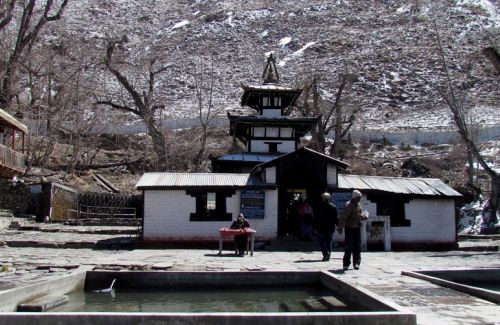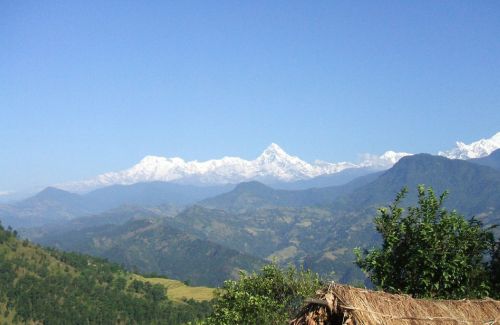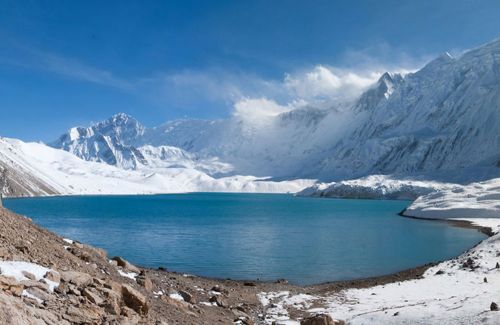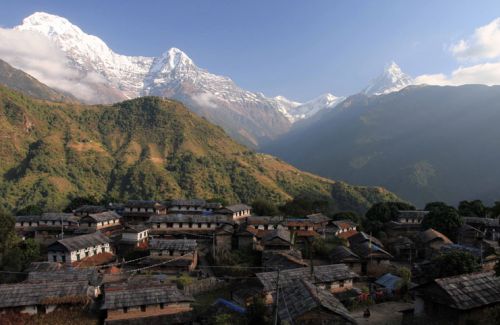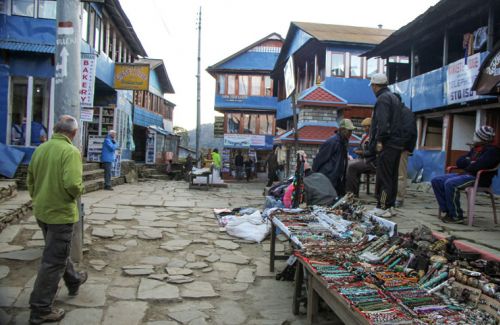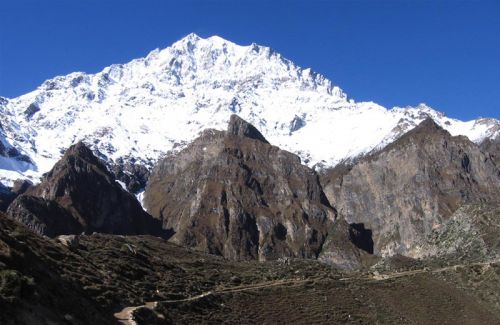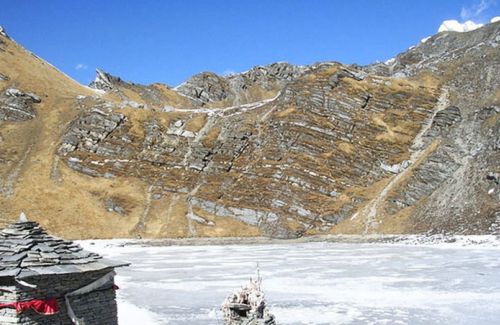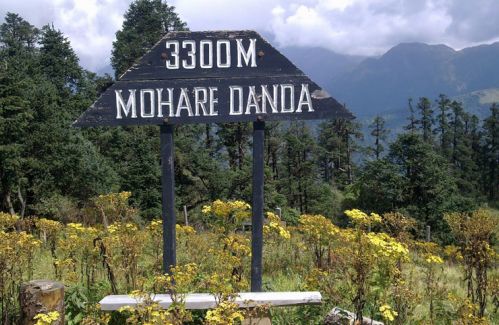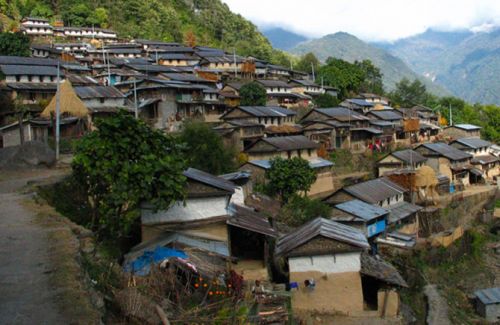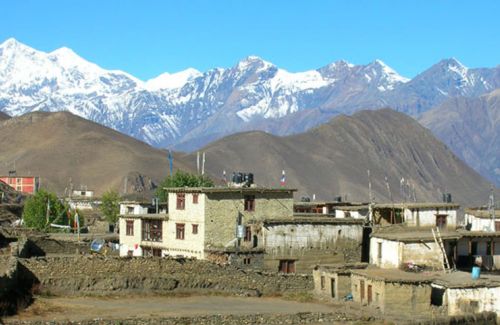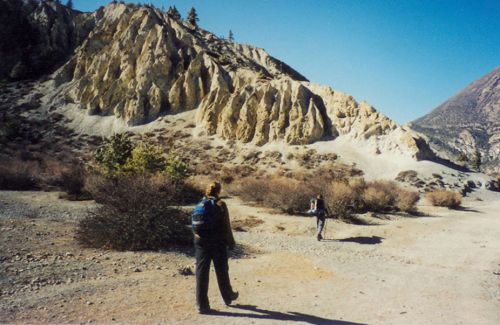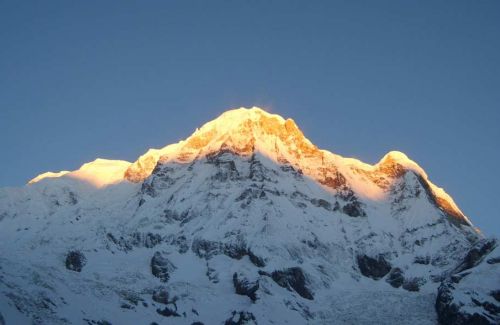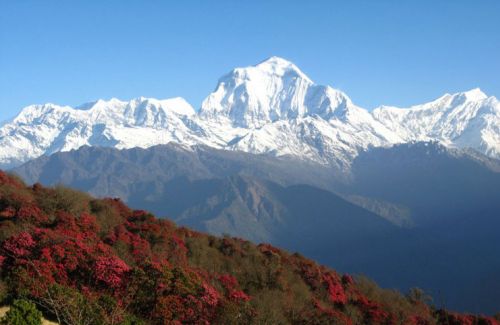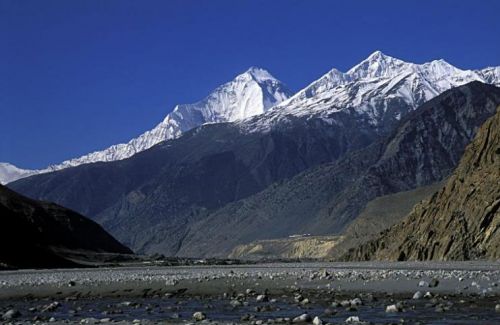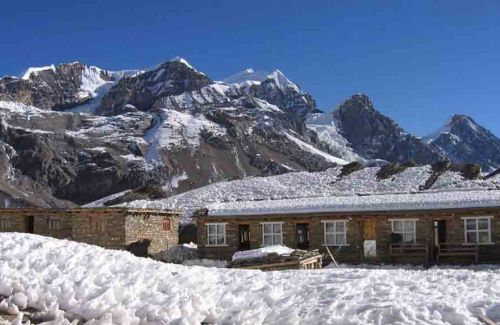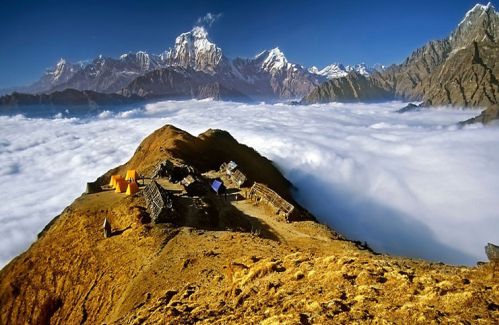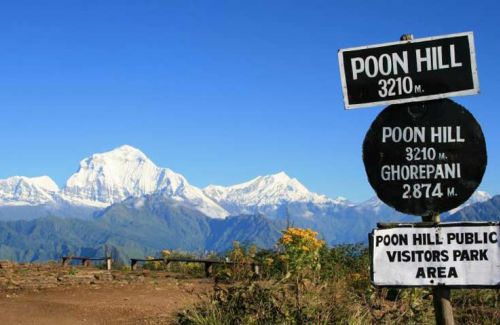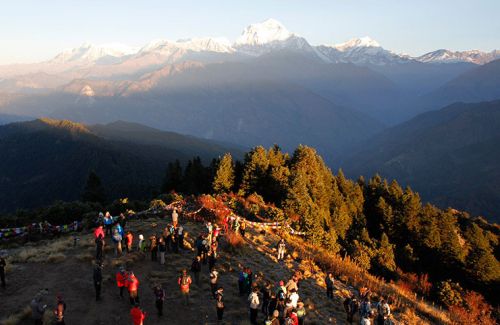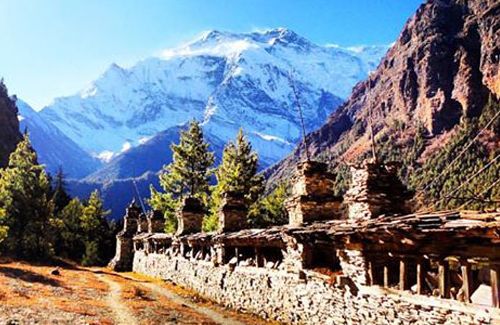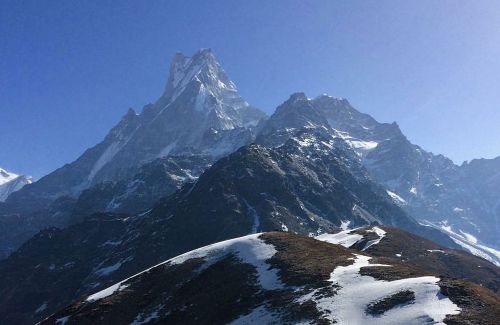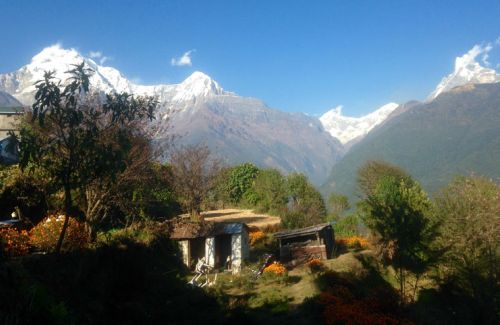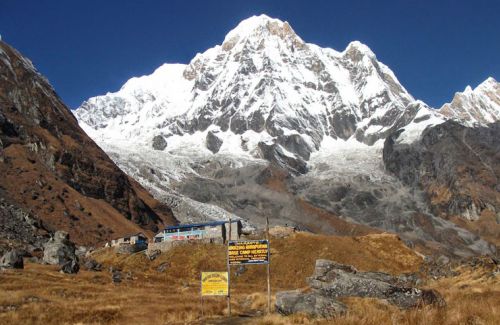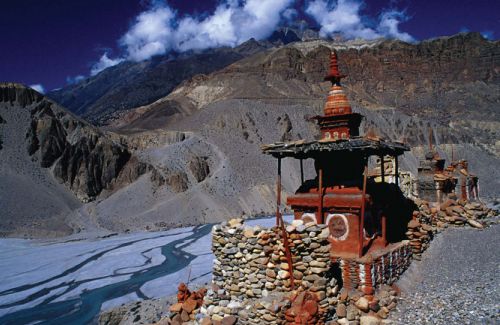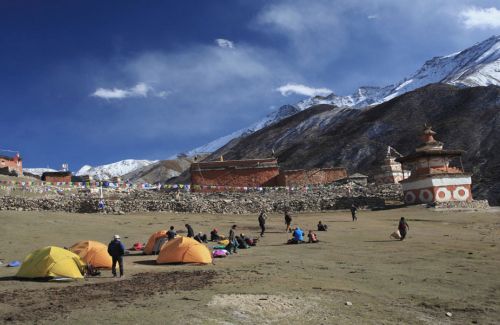Mardi Himal Trekking
- Duration11 Days
- Max. Altitude4,120 m
- Starts FromUSD 850
Destination:Nepal
Trip Grade:Moderate (**)
Meals:Breakfast + Lunch + Dinner
Transportation:Private Vehicle/Tourist Bus
Accommodation:Lodge
Best Season:February to May & September to December
Show AllMardi Himal Trekking is newly explored route, the least trodden trail, in a long rising ridge and its summit that from the south westerly lower slope of Mt. Machhapuchhre. Mardi Himal Trek is a secret asset. As it is not widely known by many people, few trekkers make their way to Mardi Himal Base Camp.This trek is splendidly situated at the base of Mardi Himal and the impressive Machhapuchhre. The first ascent to the Mardi Himal was in 1961. The first route was through its east flank.
Trek Mardi Himal is highly regarded as an Eco-Tourism route in Annapurna Region. We find many things especially the culture, natural vegetation and wildlife in originality, not disturbed. Many things to venture out more than anyone has expected. As it is least visited, there is no effect of mass tourism and we feel the genuine, rich, elegant, unspoiled ,immeasurable diversity of nature. So, one could find the decent, simply living people and their culture on its lap. We acquaint first hand with the alpine flora and fauna. The trail goes through rhododendron and oak forest around 3,300 m. Mardi Trek is the best to experience the hypnotic glamour of the nature.
Mardi Himal is located in the east of Modi Khola and the landscape changes abruptly into a rough high mountain landscape, with amazing view of Mardi Himal, Machhapuchhre ,Annapurna South and Huinchuli. Particularly, this trek offers the chance to view the golden sunrise over an iconic, sacred Machhapuchhre. The scenery expands as the trail goes higher offering stupendous views of – Dhaulagiri (8,167 m), Mt. Annapurna (8,091 m),Annapurna II (7,937 m),Annapurna III (7,555 m), Annapurna IV (7,525 m),Annapurna South (7,219 m), Huinchuli (6,441 m) and Machhapuchhre (6,988 m).
We can begin our trek from Phedi, one hour drive from Pokhara then goes to Pothana Deurali where we spend the night there. From Pothana , the trail passes towards High Camp via the Forest Camp. From High Camp (3,580 m), we can climb in about 3-4 hours to Mardi Himal Base Camp which offers a majestic views of Annapurna massifs. After that we move to the beautiful village of Sidhing and Hyangja kot via Lwang.
We can find the simple guest house and home stays along the route. It is not necessarily to be an experienced trekker for this route. The precaution about the symptoms of altitude sickness would be enough. This is the moderate trek that is highly recommended to do to get newness from the new trail.
Himkala Adventure is responsible trekking company to promote new trail worldwide and to preserve the soul of Himalayan secrecy and reality. We have held a different portfolio because we execute trekking activities differently and contribute for the environmental existence. Your trek to Nepal through Himkala Adventure, stepping in the outlying area, your participation to understand people and support them buying local products etc. make you feel great of your life time experience. You just make up your mind, no matter any route you prefer, we are there to serve you the best.
Trip Highlights
- Full day sightseeing in UNESCO World Heritage Sites in Kathmandu
- Scenic drive from Kathmandu to Pokhara through countryside
- Beautiful Pokhara Valley and the Phewa Lake
- Best Panoramic view of landscape
- Traditional villages full of diverse culture
- Beautifully decorated Rhododendron forest
- Surrounding towered by snowy peaks of Annapurna, Machhapuchhre and others
- Rich flora and fauna on the untouched land
Day to Day Itinerary
Day 01:Arrival in Kathmandu (1,350 m) & Transfer to Hotel. Overnight at Hotel
Day 02:Pre-Trip meeting and Full day valley sightseeing in Kathmandu. O/N at Hotel
Day 03:Drive from Kathmandu to Pokhara (827 m),6 hrs. O/N at Hotel
Day 04:Trek from Pokhara to Pothana (1970 m), 5 hrs. O/N at Guest House
Day 05:Trek from Pothana to Forest Camp (2550 m), 7 hrs. O/N at Guest House
Day 06:Trek from Forest Camp to High Camp (3,580 m), 6 hrs. O/N at Guest House
Day 07:Trek from High Camp to Mardi Himal Base Camp (4,120 m), 5 hrs
Day 08:Trek from High Camp to Siding Village (1280 m), 7 hrs. O/N at Guest House
Day 09:Trek from Siding Village to Pokhara (850m), 2.5 hours trek and 1 hour drive. O/N at Hotel
Day 10:Drive from Pokhara to Kathmandu, 200 km, 6-7 hrs. O/N at Hotel
Day 11:Departure to the International Airport
Cost Include
- Airport picks up & drops off by private tourist vehicle
- Three nights in Kathmandu and 2 nights in Pokhara in twin sharing basis accommodation at 2-3 star with Breakfast
- Guided city tour in Kathmandu by private tourist vehicle
- Full Board Meal (Breakfast + Lunch + Dinner) during the trek
- Lodges, Guesthouses accommodation during the trek
- Professional license holder English speaking guide.
- The required number of local staff and porters (2 trekkers = 1 Porter)
- Food, accommodation, salary, insurance, equipment and medicine for all staff
- Annapurna Conservation Area Entry permit and TIMS card for trekking
- Down Jacket, Duffle bag and sleeping bag by Himkala Adventure if required
- Drive from Kathmandu - Pokhara - Kathmandu by tourist coach
- Farewell dinner with Nepalese Cultural Show
-
Government taxes, VAT and service charge
Cost Exclude
- Lunch and Dinner in Kathmandu and in Pokhara
- Personal Expenses ( Phone Bills, Bottled or Boiled water, Bar, Laundry, Shower etc.)
- Nepal Entry Visa Fee
- Your Travel Insurance
- Emergency Rescue Evacuation
- Personal Trekking Equipment
- Tips for the trekking, tour staffs, driver (Tipping is expected)
- Any other expenses that has not been mentioned in the Cost Includes Section
Detail Itinerary
Day 01Arrival in Kathmandu (1,350 m) & Transfer to Hotel. Overnight at HotelWe are glad to welcome you in Nepal at Tribhuvan International Airport. It is about 5 km far from airport to Thamel. We drop you in the hotel. You can spend rest of time to get refreshed and walking around Thamel. Overnight at Kathmandu
Day 02Pre-Trip meeting and Full day valley sightseeing in Kathmandu. O/N at Hotel After breakfast, we go for city tour. Our guide explains all about the historical and cultural implications. The places you visit are masterpiece in art and architecture. The monastery, stupas, monks circumambulating around is worth seeing. After city tour, we return back to Hotel and brief you about the Mardi Himal trekking. Overnight at Kathmandu
Day 03Drive from Kathmandu to Pokhara (827 m),6 hrs. O/N at Hotel Early in the morning, after breakfast, we start our journey to Pokhara. It is 200 km from Kathmandu to Pokhara but it takes 6-7 hours. Driving through this highway is pleasant. Overnight at Pokhara
Day 04Trek from Pokhara to Pothana (1970 m), 5 hrs. O/N at Guest House After breakfast, we drive from Pokhara to Dhampus. These days, there is rough, dusty road direct to Dhampus via Shimpani, and after 18 km Ghatte Khola. After Dhampus, it is an hour walk up hill then we reach to Pothana. It is the good location for the Mountain View. We can trek from Phedi to Pothana as well. We can drive to Kande and start our trek to Dhampus, We pass through the rhododendron forest, terraced field, little hamlet en route.
Day 05Trek from Pothana to Forest Camp (2550 m), 7 hrs. O/N at Guest House After breakfast, we climb steep way through beautiful forest along with the amazing views of the Dhaulagiri and Annapurna. The vegetation and wild life of this region can be great resource for the researchers. We arrive at Forest camp and take a rest. Overnight at Forest Camp
Day 06Trek from Forest Camp to High Camp (3,580 m), 6 hrs. O/N at Guest HouseHaving breakfast, we follow the trail that goes through the forest enriched by mosses, lichen, tree ferns, and orchids. The trail traverses towards the Annapurna South and far below, towards our left we see the Modi Khola Valley that leads up to the Annapurna Sanctuary. After short, steep climb we get out of forest and hit the ridge, grassy and some parts full of snow, takes us to the High Camp. From here, the Annapurna South and Machhapuchre seem very close. Overnight at High Camp
Day 07Trek from High Camp to Mardi Himal Base Camp (4,120 m), 5 hrs Mardi Himal Base Camp is the highest point of this trek. We get up early I the morning and set out for the hiking. The sunrise over the mountains would be fantastic. We follow the narrow paths through the Rocky Mountains. We finally reach to the point, and view the great Himalayan range. Overnight at Mardi Himal Base Camp
Day 08Trek from High Camp to Siding Village (1280 m), 7 hrs. O/N at Guest House After breakfast, we descend down through the forests and terraced fields. We arrive at Mardi Khola. From Mardi Khola, we take the trail following the bank of Mardi Khola to the village of Siding. The picturesque sight of farmland, paddy fields and less walked trail show the virginity of this region. After this, we reach into the idyllic countryside- Siding. Overnight at Siding
Day 09Trek from Siding Village to Pokhara (850m), 2.5 hours trek and 1 hour drive. O/N at Hotel After breakfast, we follow the river valley gradually down between the pastures and the settlements of Gurung and Tamang people. After this the trail goes round an outcrop and we meet the road. From there, we drive back to Pokhara. Overnight at Pokhara
Day 10Drive from Pokhara to Kathmandu, 200 km, 6-7 hrs. O/N at Hotel It is 30 minutes flight from Pokhara to Kathmandu. After breakfast, we go to Pokhara airport and board on the plane, this flight offers scenic beauty over the Himalayas, greenery of the hills and the picturesque countryside. If we drive by Prithivi Highway, which is 200 km from Pokhara to Kathmandu gives the real village scene and terraced farm lands. Overnight at Kathmandu
Day 11Departure to the International Airport If you have enough time before your flight, you can visit local market for buying souvenirs for your families and friends. The visit to the bustling market around Asan, Indrachowk and buying spices, fancy jewelries, garments and other typical ethnic items give the real satisfaction. We transfer you to the airport 3 hours before your flight towards the onward destination. Namaste!!!
Trip FAQ
Himkala Adventure would like to quench the thirst of all necessary questions answers about Mardi Himal Trekking for all curious travelers/trekkers in the world. As you are entirely from different geographical location, you could better to know everything about the treks from the beginning i.e. airport pick up till your departure like airport picks up, drops off, accommodation in city, in the trek, guide and porters, safety for the trekking, food and accommodation and some other things that you might face on the way. Hope our endeavor listing these questions answers will help you self informed.
This is simply the outlines of the services we offer but it may differ as per your requirement, number of trekkers. What we go through our conversation, we will manage the means of transportation, hotels in the city, accommodation in the trekking, numbers of porters etc. This is general idea about Mardi Himal trekking before your trip and you become clearer about the trek. Please feel free to contact us to get more information about the trekking in the Himalayas of Nepal.
1) How is Mardi Himal Trekking in Nepal?
Mardi Himal Trekking is an alternativer trekking trail of Annapurna Region in the western part of Nepal.The newly explored trek reaches up to 4,120 m from the sea level. It is a moderate trek and can be done by anyone. Mardi Himal trek is untouched, and newly explored reason with much more secret treasure. Few trekkers make their way to the Mardi Himal Base Camp spectacularly situated at the base of Mardi Himal and the impressive Machapuchhre.The trail goes along small winding paths, through magical rhododendron forests until you climb out of the forest at an elevation around 3,300 m. The landscape changes quite abruptly into a rugged high mountain landscape, with amazing views of Mardi Himal, Machapuchre, Annapurna South and Hiunchuli.
2) What physical fitness do I need to book this trip?
Every trekking in the Himalayas of Nepal require the certain level of physical and mental fitness.So, we advise you to be in good physical shape and able to feel comfortable while hiking up and down 7 to 12 miles per day on a trail carrying a day pack of about 10 pounds. Three things could make you confident enough for any trek you would like to do: aerobic, strength and mental.
Aerobic conditioning is important primarily because you will be trekking in thinner air, up to 40% less than at sea level. With good aerobic conditioning, you will be able to better metabolize whatever oxygen is available to you. You should plan on doing at least one hour of aerobic 3 /4 times per week for 1 month or more before your arrival in Nepal. Walking, jogging, cycling, hiking on valley floor to ridge line ascents with day back are some of the excellent forms of exercise, so long as you are strengthening leg muscles and building stamina. Speed is not the essence; stamina, confidence and continuity are.
3) How do I find Himkala Adventure for my pick up at the airport?
Our representative from Himkala Adventure will display a small board of company or your name on the sheet of paper outside the airport terminal. You will be driven to the hotel by our tourist vehicle.
4) What sort of accommodation do I get in Kathmandu and Pokhara ?
Normally we provide standard rooms with twin sharing accommodations at three star or similar category hotels in Kathmandu and Pokhara including breakfast. Accommodation in these cities can be upgraded as per your request. But some of our packages are sold without accommodation in the city.
5) How are tea house facilities during Mardi Himal Trekking?
Tea House is the combination of guest house, restaurant, and social hang out. Tea houses in Mardi Himal Trekking area are highly professional though they are simple but with neat and clean lodging offering fine views and plain but fresh and hygienic food with friendly atmosphere Most of the Tea Houses have running water facility. Many of them have hot water available for bathing. But we discourage our groups from using water heated by wood as lack of firewood in most villages is a big environmental concern in Nepal.
6) What sort of accommodation do I get in trekking?
Guesthouses/Tea Houses/Lodges provide twin sharing single and double rooms and occasionally a dormitory which is basically clean with a mattress and a quilt or blanket. Our company provides the sleeping bag if needed but we always recommend having your own sleeping equipments. You have to share the room with your group member or sometimes with unknown traveler. The toilet is always outside the room with basic facilities.
7) What sort of foods, water and drinks can I expect in trekking?
The foods in the Himalayas are very simple. There are mostly the family members themselves to cook and serve the meal. They are simply trained but experienced because they have been offering such services for many years in this busy route. The food is hygienic, fresh and delicious. We recommend you to drink mineral water or the boiled or using water purification pills or drops.
Most of the foods are cooked in the kitchen of tea houses. They serve you with different varieties of delicious Nepali and continental dishes. The most popular Nepali food is daal bhat (rice and lentils) with some mixed vegetable curry. Garlic soup is popular as it helps you with acclimatization. You could better be vegetarian in the mountains. All hotels in cities and guesthouses in trekking serve the vegetarian food. You can find all common types of drinks like hot chocolates, coffee, tea, hot lemon with honey, ginger tea, soft drinks etc. you will have your breakfast and dinner at the lodges where you will be staying and lunch somewhere on the way to your next destination.
8) What mode of transportation do I use?
We will provide the private transportation for Airport/Hotel/Airport pick up and drop and sightseeing in Kathmandu Valley. We use transportation as based on our cost inclusion section. The transportation varies depending on your requirements at the time of booking the trip.
9) What is the best season for this trekking?
The best season for Mardi Himal Trekking is spring (March to May) and autumn (September to December). These are the perfect time of the year for the breathtaking views of Himalayas with clear and sunny days. But the weather in the mountains is unpredictable.
10) What is the weather and temperature like during the trekking?
The climate in Nepal varies from place to place which can be categorized in different four main seasons. The main seasons in Nepal are spring (March to May), summer (June to August), autumn (September to November) & winter (December to February). The best season to travel in Nepal is autumn (September, October & November) & spring (March, April & May). Weather in the mountains is unpredictable. But the day temperature in Mardi Himal Trekking is comfortable.
11) Who will be guiding me during this trip?
We provide the professional government license holder English speaking trekking guides for our entire trekking trip. We can also provide French, Spanish, Japanese, German or Italian speaking guides as per your preference with extra payment but not guaranteed. All guides will be Nepali people who are carefully selected on the basis of their appropriate experience, leadership skills and personality. They are all trained from Nepal Academy of Tourism and Hotel Management, certified and approved by the Tourism Department of Nepal government. We provide a different city tour guide to guide you in UNESCO World Heritage Sites in Kathmandu. They are the professional license holder guide specialized in culture, history, geography, iconography, archeology and religion with good command over English. Tour guides are specialized in city tour and trekking guides are more in the hiking and trekking in the Himalayas.
12) What sort of experience do your guides have?
Our entire city tour guides have bachelors to Master Degree academic education along with many months tour guiding training from Nepal Academy of Tourism and Hotel Management, Rabi Bhawan, Kathmandu, Nepal. They are fluent in spoken languages and informative about the sites in many aspects. They are quite experienced and dedicated to their job and responsibilities.
Our entire trekking guides have minimum Intermediate to Master Degree academic education with trekking guide training from Nepal Academy of Tourism and Hotel Management, Rabi Bhawan, Kathmandu, Nepal. Many of them are from villages. As they are local, they know more about the routes, necessary precaution to be taken and so on. They have spent many years exploring many parts of the country. They are trained in first aid and able to handle any situation easily. They speak good English and make you know about the places you visit.
13) May I charge my electronic gadgets during Mardi Himal Trekking?
Most of the places in your tea houses have charging facilities. You can charge your devices by paying some extra money. It’s good if you bring TWO or THREE pin travel adapter and put your gadgets at warm place at night.
14) How much additional money is required for this trip?
It’s a very personal question as expenses depend on habit. Normally, in Kathmandu you can allocate about USD 10 to 15 per person per lunch or dinner. USD 10 to USD 15 per person per day will be sufficient to buy bottles of water, chocolates, pay for a hot shower during the trekking. Other personal expenses will be your own calculation.
15) What is the social and environmental responsibility of Himkala Adventure for this trip?
The situation of environment in Nepal is in considerable stage due to so many factors caused by global warming, human activities, and adverse effects of natural incidents. Nepal is in between two giant countries like China and Nepal. The ozone layer is depleting and the atmosphere is getting heated. So, its direct effect is to the Himalayas that the snow is melting day by day and the sea level is rising. It is due to population growth, people are clearing the forest and the soil is being eroded. As a part of society, and our trekking related activities are directly concerned with the social and environmental things. We are very conscious not litter in the open spaces, to manage garbage properly and make local people aware in this campaign. We are working together with other companies and taking these issues seriously.
16) What is the minimum number requirement for this trip?
We operate individual trip to the group joining trips for Mardi Himal Trekking. If you want to do any private trip we are ready to organize for solo traveler as well with some additional charges.
17) Are there communication or internet services during Mardi Himal Trekking?
All guesthouses/lodges in Mardi Himal Trekking trails have telephones and internet services. They provide the WIFI service with some extra charge which helps to get updated with social Medias, friends or family. All our guides carry the local mobile phone. You can use his mobile phone to make any local or international call from trekking trails by paying him directly. You can even pass him number to be connected with your family or friends. We highly recommend taking local SIM card for call and internet services during trekking. Local SIM cards are easily available in many stores and at airport as well. You need to provide two copies of your photographs and your passport copy to get local SIM CARDS of NCELL & NTC (only these two companies provide telephone services in Nepal
18) May I get chances for shower during Mardi Himal Trekking?
Most of the guesthouse provides hot shower with some extra cost. In few places, bucket water will be provided for the shower.
19) May I add extra days in trekking?
We are ready to operate your holidays as per your interest and requirements. You can spend extra days on your loving or favorable places or even can make it shorter. We will always do our best to manage your hotel bookings, flight booking and everything.
20) What happens in case of emergency?
Himkala Adventure has prepared for any emergency situation and knows how to handle it. Our guides are trained in first aid and can deal with most of the basic ailments that occur during the trek. Every client should have his own insurance before coming to Nepal for the case of emergency.
21) Do I need to have insurance for this trip?
We request you to have a travel-insurance policy to cover theft, loss, medical problem & emergency helicopter evacuation from high altitude places before coming Nepal. Choose a policy to cover your emergency high altitude helicopter evacuation with all medical insurances for trekking in high altitude in the Himalayas of Nepal. Your travel insurance is always needed before going in any high altitude trekking. Please check your travel insurance policy which doesn’t exclude mountaineering or alpinism. Although you will not be engaging in these activities in your trekking, you might have problem convincing the insurance company of this fact. Rescue insurance need to cover an emergency helicopter evacuation or a charted flight from remote mountain trails of Nepal as well as international medical evacuation. A helicopter evacuation might cost US$ 2500 to US$10000 depending on the places. So that travel insurance to cover all above is must to travel in the high Himalayas of Nepal.
22) What is the baggage allowance from/to Kathmandu – Pokhara flight?
One can fly from Kathmandu to Pokhara. It is scenic flight over the mountains which takes 25 minutes.Normally, it is 20 kg free allowed per head flying from/to Kathmandu – Pokhara flight. If we have bought tickets in a group then it calculates member and multiply 20 X ..., rest we need to pay approximately USD 1 per Kg. They allow up to 7 kg for the hand carry.
23) What type of shoes should I wear during Mardi Himal Trekking?
You could better have carefully chosen hiking boots which should be kind of strong, well-made but light boots for Mardi Himal Trekking. Shoes and boots are best to buy before arriving in Nepal. We advise you to wear your new shoes for sometime before trek so that you could feel well habituated on the newer trail for your feet.
24) Can I use credit cards in the Mardi Himal Trekking route?
Of course not, you can use only in the cities like Kathmandu, Pokhara but not in Mardi Himal Trekking route. When you are out of city, all you need is cash, better to have small notes. Please change the currency in local Nepali rupees before you go to the mountains.
25) Do I need to tip my guide and porter? How much would that be?
Tipping is not mandatory, neither it is right to ask by anyone but it is a way of showing gratitude after taking service. The level of tip also shows how satisfy you are from the team that you had been during your tour/trek.However, we recommend you to spend minimum 10% of your total trip cost for tipping entire local staffs, the ratio of tipping guide and porter will be given to you at the pre-trip meeting in Kathmandu before starting the trek.
Trip Note
Cost:
The cost of trip varies according to the number of travelers in the group, the category of the Hotel, mode of the transportation and any kind of changes (if there is). So, if you would let us know all of these above mentioned things, then we could quote you the exact price.
Walking Trails:
There are stone steps up and down in most of the trekking routes in Annapurna Region. So, you might find a pair of trekking poles very useful.
Weather:
The main trekking season in Nepal is from October to December and March to May. The day temperature for walking to Mardi Himal Trekking is comfortable. The sky is clear although there is snow and rainfall occasionally. It is about 10 degree centigrade at the height of 3,600 m and increasingly lower, the higher we go.
Nepal Strikes:
There is much more progress in the political scenario in Nepal and we assure you that travelling in Nepal is safe. But there may be Bandha (wide transport strikes) at a very short notice. The shuttle bus is in operation by Nepal Tourism Board and the Nepal Tourist Police in conjunction with the Himalayan Rescue Association from domestic and international terminal to the various hotels in Kathmandu. The service costs 300 rupees per person.
Itinerary Disclaimer:
Himkala has thoughtfully designed all the itineraries but our itineraries are updated for the betterment on the basis of our past travelers’ comments and our own research. In case you find changes in the itinerary you printed and the upgraded one does not affect your trip. Please note that some changes may occur in our itineraries due to bad weather and common seasonal changes to timetables and transport routes.
Physical Rating:
Your trip will be meaningful if you could find yourself fit and fine. You will be walking up to 4,120 m from the sea level. As the geographical region varies, there is a temperature variation as well. So, we advise you to undertake regular physical exercise, jogging, hiking, riding, ascending and descending the long stairs etc.Precautions and acclimatization are undertaken but be aware of the effects altitudes can have.
Group Size:
Himkala Adventure organizes solo to group travelers. Our group trips are designed for sharing accommodation and there is no single supplement. Single travelers share with the same gender from twin to multi-share in an accommodation. You are requested to have mutual understanding in between the fellow travelers who have joined from the different parts of the world. Please remember that you have great responsibilities in the group. If you are requested to be at a particular place at a certain time, make sure that you have been there at a time. It is much more pleasing sharing experiences and traveling together.
Accommodation and Meals:
Accommodation and Foods in the Himalayan region of Nepal cannot be compared with any developed countries in the world. We know that you might not have experienced such things before but you should take it easy. Accommodations at local lodges are simple but clean and comfortable. The food is plain. Toilets and washing facilities are shared and rudimentary. In high altitude regions, there are very few tea houses and one has to be happy to share in simple dormitories without electricity, without running water. Hot shower means a bucket of hot water upon our request.
Money Matters:
Please note that most establishments in Asia will not accept foreign currency notes that are old, torn or faded and they can be very difficult to exchange or extra fees added when exchanging at banks. Please ensure that you have new, clean notes.
The official currency of Nepal is the Nepali Rupee (NPR). ATMs can be found only in major cities of Nepal like Kathmandu, Pokhara, Chitwan, Bhaktapur etc. The government of Nepal has banned the import, export and use of 500 and 1000 Indian rupee notes in Nepal. You make sure that you won’t carry these notes upon arrival in Nepal, otherwise they are confiscated and you may be fined.
Please make sure that the foreign currency notes that you have are new and clean notes because old, torn or faded foreign currency notes in Nepal are very difficult to exchange or extra fees added when exchanging at banks.
While travelers cheques have security advantages exchanging them can be a lengthy process, commissions can be high (up to 10%) and they can be difficult to change in rural areas, on weekends and public holidays. If you choose to bring travelers’ cheques, make sure they are a major brand and major currency.
Tipping:
Tipping is not mandatory. It is not anyone’s right asking for tips but if you are happy with the service, you could tip the staffs. It is entirely a personal preference. Tipping could be significant to them who took take great care of you in your traveling period. Himkala recommends that you could tip any intended recipient by any member of the group than collected and passed on by the group leader.
Note: Please do not tip with coins or dirty and ripped notes. This is culturally taken as an insult.
Local Dress in Nepal:
Nudity is a sensitive issue in Nepal. Women should avoid wearing shorts and sleeveless tops in public places where this might be seen as inappropriate. Remove shoes before entering certain holy places. Non-Hindus are not permitted in some temples.
Feedback:
Your feedback will be the great guidance to meet our target and to bring improvement in our service. What and how have you experienced with Himkala Adventure and our staff? Please write, we will read it carefully. One cannot see his/her shortcomings that are lying with them. Someone should point it out. We are always eager to hear from you.
Trip Info
- Foot Ware/Foot Care
- Health and Fitness
- Himkala Crews
- Hypothermia
- Safety and Security
- Travel Insurance and Evacuation
- Trip FAQs
- Washing and Shower
- Water/Food and Nutrition
- Trip Grading
- Weather
- Accommodation/Shelter
- Altitude Sickness
- Communications and Updates
- Conservation
- Cross Cultural Issues
- Essential Do’s and Don’ts
- Equipment List
